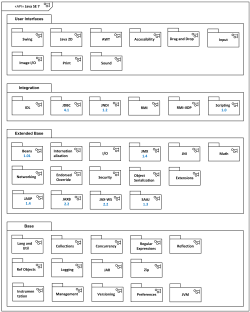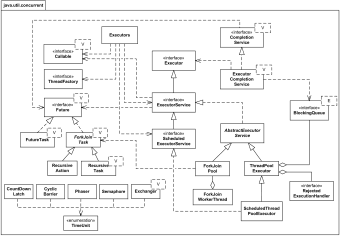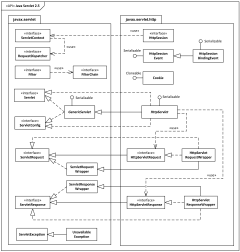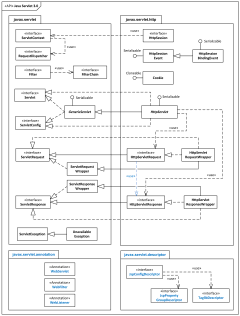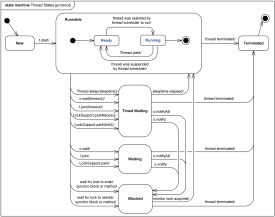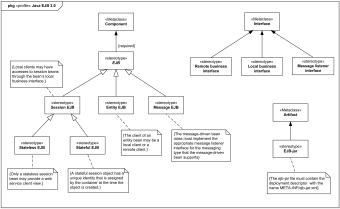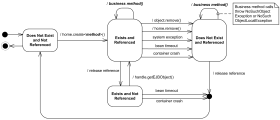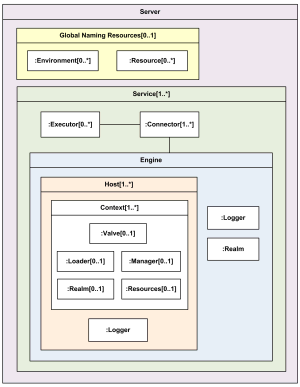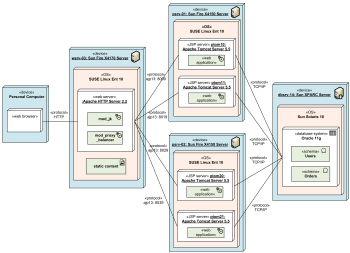UML Diagram Examples
Java™ Technology
Here we provide several UML diagrams of different types, related to Java™ technology and APIs.
Purpose: An example of UML package diagram representing Java™ Platform Standard Edition (SE) 7 API.
Summary: Java™ SE 7 API is comprised of several modules - User Interface and Toolkits APIs, APIs of Integration Libraries, Other Base Libraries APIs, lang and util Base Libraries APIs, Java Virtual Machine (JVM) API. Java SE 7 API includes such well known APIs as Swing, AWT, JavaBeans, JDBC, JAXP, JAX-WS, JAR.
Purpose: Examples of UML class diagram representing most important interfaces and classes of Java™ util.concurrent API. Several java.util.concurrent.* packages support high-level concurrency features in Java with the new concurrent data structures in the Java Collections framework.
Summary: Executors define a high-level API for launching and managing threads to support large-scale applications mostly by adding thread pool management abilities. Concurrent collections reduce the need for synchronization and are designed to support concurrent access and modifications of the large collections of data. The Future<V> interface represents the result of an asynchronous computation.
Purpose: An example of UML package diagram representing most important interfaces and classes of Java™ Servlet 2.5 API.
Summary: Java Servlet 2.5 API consists of two packages: javax.servlet and javax.servlet.http. The javax.servlet package contains a number of interfaces and classes (both abstract and concrete) that describe and define the contracts between a servlet class and the runtime environment provided for an instance of such a class by a conforming servlet container. The javax.servlet.http is package specialized for the servlet class running under the HTTP protocol and for corresponding runtime environment.
Purpose: An example of UML package diagram representing most important interfaces and classes of Java™ Servlet 3.0 API.
Summary: Java Servlet 3.0 API consists of four packages: javax.servlet, javax.servlet.http, javax.servlet.annotation, and javax.servlet.descriptor. The javax.servlet package contains a number of interfaces and classes (both abstract and concrete) that describe and define the contracts between a servlet class and the runtime environment provided for an instance of such a class by a conforming servlet container.
The javax.servlet.http is package containing API interfaces and classes specialized for the servlets supporting HTTP protocol and corresponding runtime environment. The javax.servlet.annotation and javax.servlet.descriptor packages allow to declare servlets, filters and listeners by using annotations and to have access to a web application's configuration information.
Purpose: An example of UML protocol state machine diagram showing thread states and thread life cycle for the Thread class in Java™.
Summary: Thread is a lightweight process, the smallest unit of scheduled execution. Instance of the Thread class in Java could be in one of the following states: new, runnable, timed waiting, waiting, blocked, terminated.
Purpose: An example of UML profile diagram for Enterprise JavaBeans (EJB) 3.0.
Summary: Simplified and unofficial UML profile for EJB 3.0 with support for session, entity, and message-driven Enterprise JavaBeans.
Purpose: Life cycle of an EJB session object is shown from the point of view of a local or remote client using the EJB 2.1 and earlier client view API.
Summary: A session object does not exist until it is created. When a client creates a session object, the client has a reference to the newly created session object’s component interface.
Purpose: Show a simplified composite structure of a non clustered Apache Tomcat 7 web server.
Summary: A Server element represents Catalina servlet container of Apache Tomcat 7 web server. It is a single outermost element in the conf/server.xml configuration file. Server element could contain optional Global Naming Resources component and one or more Services. Each Service element is a composition of Executors and Connectors that share a single Engine component.
Purpose: An example of deployment diagram for J2EE web application with load balancing and clustering which shows specific server instances involved.
Summary: Incoming HTTP requests are first processed by Apache web server. Static content such as HTML pages, images, CSS, and JavaScript is served by the web server. Requests to JSP pages are load balanced and forwarded to 2x2 Apache Tomcat servers using both vertical and horizontal clustering.
Purpose: An example of UML deployment diagram with hardware and software load balancing and clusters.
Summary: An example shows 2 active hardware load balancers connected to 2 to 4 Sun Fire Servers. Each server has 3 instances of IBM WebSphere 7 J2EE application servers installed.
